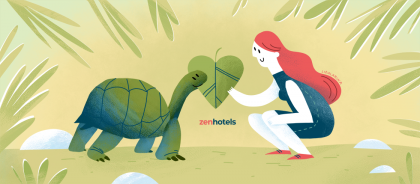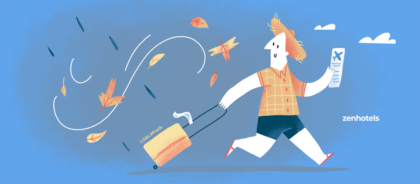Content
- How to get there
- How to travel around
- When to go
- Where to stay
- Where to eat
- What to see
- Trekking routes
- Where to swim
- What to bring back
- What you should remember before your trip
International Travel
The Seychelles opened its borders to unvaccinated tourists on March 25. Arrivals will only need a PCR test no older than 72 hours. Prior to departure, you must receive a paid entry permit.
How to get there
The Seychelles are located in the western part of the Indian Ocean. They consist of 115 islands, of which only 33 are inhabited.
Direct flights to the Seychelles from the UK are offered by British Airways, from France (Paris) by Air France, from Germany (Frankfurt) and Switzerland (Zürich) by Edelweiss Air.
If you travel with a layover then there are, of course, many other airline options, including Etihad Airways (via Abu Dhabi), Emirates (via Dubai), Ethiopian Airlines (via Addis Abeba), Turkish Airlines (via Istanbul), and Qatar Airways (via Doha).
The International Airport of the Seychelles (Abbreviation: SEZ) is located on Mahé, around 10 km south of the capital city, Victoria. All international flights land here.

The Seychelles are located in the western part of the Indian Ocean. Photo: My Lovely Planet / Shutterstock.com
How to travel around
A big advantage of Mahé is that you can see it by bus. In Victoria, the capital city, there is a bus station, from where buses travel to any place in the islands. The cost of transportation (regardless of destination) is 12 rupees. You can check the schedule and departure platform with the station attendant.
In Seychelles, they speak English, French, and Creole.
For example, you can take bus number 5 from the airport to Victoria. The stop is located near the airport’s exit. The disadvantage of this method of transport is that you may wait for transportation for 30-40 minutes in the heat. I booked a transfer from the airport to the apartment; I paid 35 euros one way, although I could have got there on my own.
The best option is to rent a car. Car rental prices on the island start at 35 euros. A car rental place is located near Beau Vallon Beach.
A taxi is the most expensive option for tourists. For example, a taxi ride from the airport to Victoria may cost 50 euros, and it may cost 100 euros to reach the other end of the island.

Graffiti at the bus station in Victoria.
When to go
Seychelles is a year-round destination. The thermometer stays at around 27-28°C all year round. It rains mainly at night. The ideal months for visiting the islands are from May until October. Precipitation is slightly less during this time period.
Climate changes have been noted on the islands in recent times. Thus, in September 2022 – the dry season – it rained for several days, although this did not bother the holiday at all and the temperature of the air and water remained high.
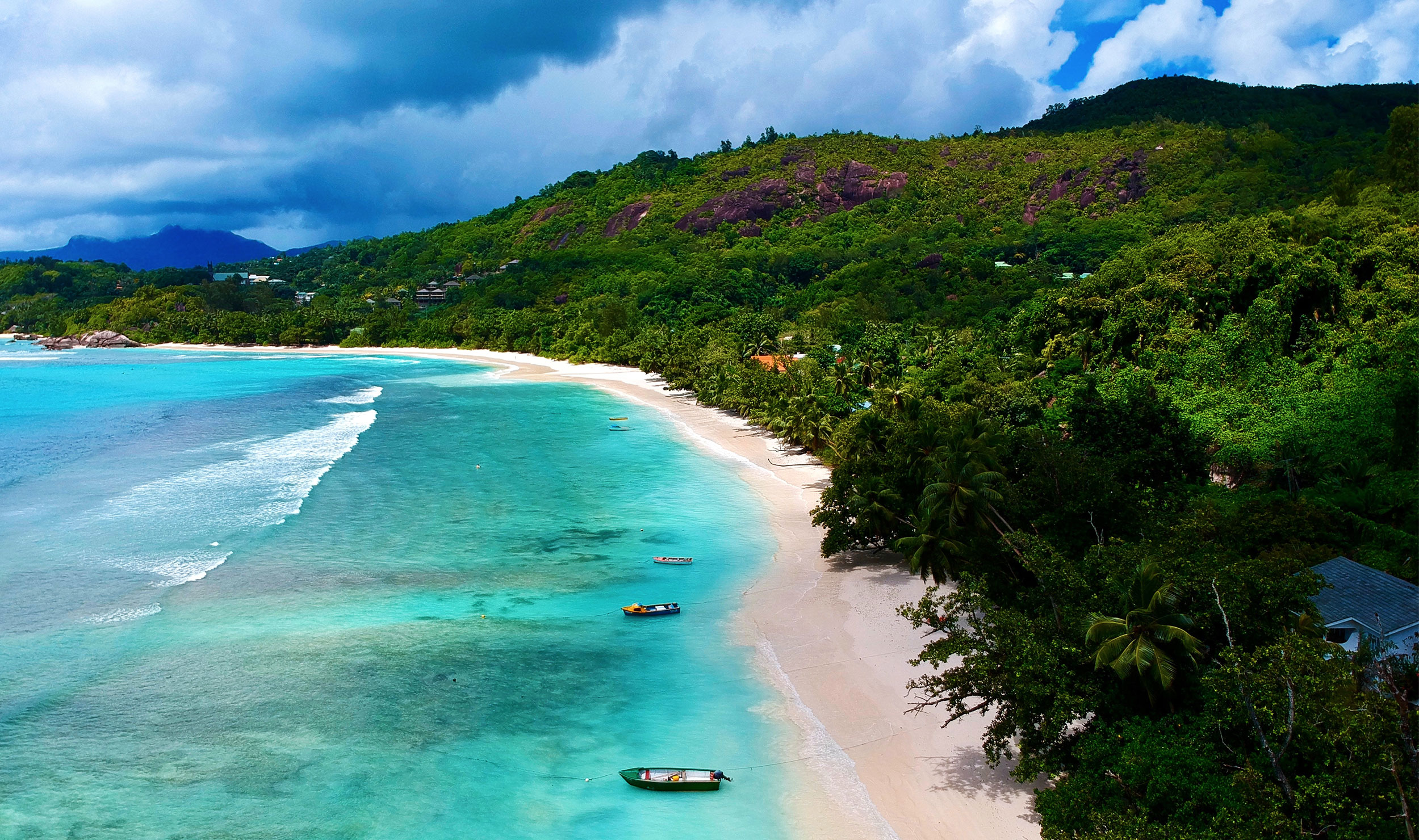
Seychelles is a year-round destination. Photo: goldisworld / Shutterstock.com
Where to stay
We compiled a list of inexpensive hotels where you can stay in the Seychelles in a separate article. In my opinion, the best option for a budget trip is to book an apartment. I stayed at the Oceanic View Apartments. The apartments have a kitchen where you can cook food and a balcony with a view of the mountains and ocean.
I traveled all over the whole island and recommend choosing a place in the Beau Vallon region. The primary reason for choosing this place is because it’s easiest to get from here to the capital, from where you can then take a bus and travel further to any part of the island. Most activities are concentrated in Beau Vallon: there are cafés and restaurants, you can book an excursion to other islands, and relax on the beach of the same name. This beach may not be the most picturesque on the island, but it’s one of the most convenient ones for swimming.

View from the Oceanic View Apartments.
Where to eat
The only disadvantage of the Seychelles is that you should not expect gastronomic delights here. The food here is as simple as possible: rice and curry, fish, or grilled octopus. Most of the restaurants are concentrated on the Beau Vallon Beach or near the hotels.
In the course of a week, I was at the Indian restaurant Mahek twice. It is considered to be one of the best restaurants, but prices here are not low. For example, a portion of octopus or fish in curry with coconut milk and rice will cost you 350 rupees.
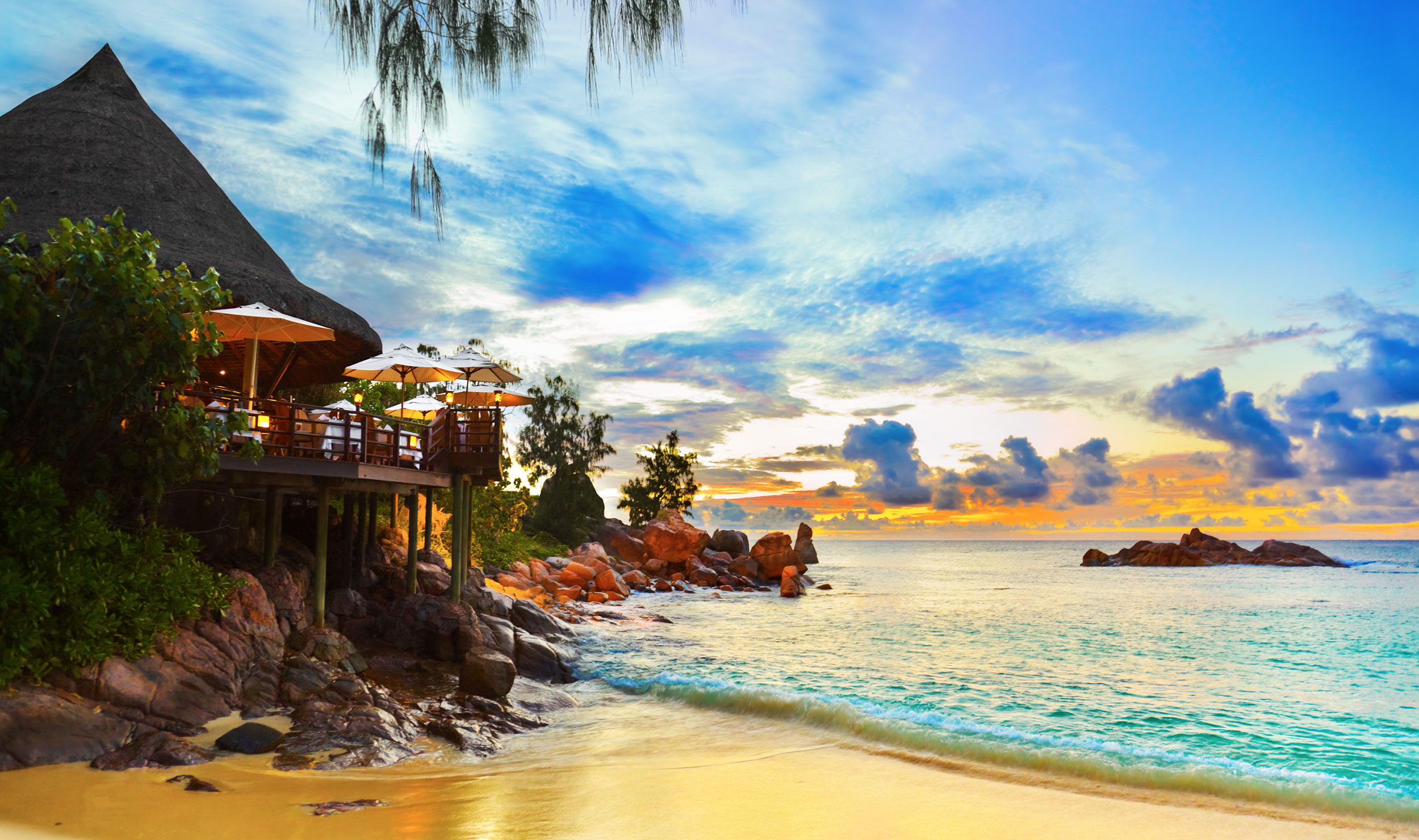
The only disadvantage of the Seychelles is that you should not expect gastronomic delights here. Photo: Tatiana Popova / Shutterstock.com
The rest of the time, I bought food in the supermarket: shrimp, vegetables, sparkling wine, cheese, prosciutto, yogurts, French baguette, and cooked in the evenings in the kitchen. 80% of the goods on the shelves are imported, so the price of even ordinary yogurt is not low (25 rupees). One of the unusual things in the stores is that eggs are sold individually (5 rupees per egg).
Sometimes, I bought fruits on the beach, but the prices at Beau Vallon are higher and the quality is lower that at the market in Victoria, where you must barter. A drinkable coconut can sell for as much as 100 rupees, or as low as 50. A coconut cost 25 rupees at the market and was the most delicious of those I managed to try in a week. A kilo of papaya will cost 30 rupees at the market in Victoria. Even along the road, you may come across tents where the locals are selling fruit.

Fruits at Beau Vallon Beach.
What to see
In the capital, Victoria
The island’s capital is the business and cultural center of the archipelago. There is a hospital, a teacher training college, banks, the Seychelles Natural History Museum, a port and bus station, the only traffic light on the island, and a Hindu temple. It’s possible to see the city and its sights in half a day.
Sir Selwyn Clarke Market: This is a colorful market where you can become more familiar with the local culture. The market is located in the center of Victoria. Here you can buy fish and seafood, vegetables and fruits, souvenirs and jewelry, spices and aromatic oils. Feel free to trade boldly. It’s better to come here before lunch.

Sir Selwyn Clarke Market is a colorful market where you can become more familiar with the local culture. Photo: 22Images Studio / Shutterstock.com
Arul Mihu Navasakthi Vinayagar: This is the only Hindu temple on the islands that is named in honor of the Hindu god of prosperity and safety. The temple is located next to the Selwyn Clarke market. Its bright roof attracts the attention of tourists; you can go inside, but you can only take photographs from the outside.
Clock Tower: This is one of the most iconic historical sites in the Seychelles. The tower was erected in the center of Victoria on April 1st, 1903, in memory of Queen Victoria, who died in 1901.
A few months later, the Seychelles separated from Mauritius and became a British colony, and, in 1976, after almost 70 years, Seychelles became an independent state.

Arul Mihu Navasakthi Vinayagar and Clock Tower.
The Victoria Botanical Gardens appeared in the Seychelles in 1901. The gardens are in the form of a long promenade: you can see the flora on the way to the fauna (giant turtles). An endemic – Lodoicea (giant coco de mer) is growing here.
Instead of a visit to Victoria Botanical Gardens, you can take a trip to Curieuse Island to see the giant turtles and visit Praslin Island to catch a glimpse of the giant coco de mer. The gardens are open from 8 a.m. until 5 p.m. The admission fee is 150 rupees. Admission is free for children under 12 years old.
Cathedral of Our Lady of Immaculate Conception: The Cathedral of Our Lady of Immaculate Conception was built in the French colonial style in 1874. Masses are held here on Sundays. The tomb of Félix Paul, the only bishop in the entire history of Seychelles, is located on the cathedral’s grounds.

Inside the Cathedral of of Our Lady of Immaculate Conception in Victoria.
On the island
Sauzier Waterfall in Port Glaud: This is the largest and most picturesque of all the waterfalls on Mahé. It is 200 meters high. It’s possible to swim at the base of the waterfall, however, the temperature of the water coming from the high mountain springs is noticeably lower than temperature of the ocean.
It’s possible to get to Sauzier Waterfall by car or by bus from Victoria to Port Glaud station. Admission to the waterfall is 50 rupees for adults and 25 rupees for children. It’s possible to see the waterfall from 9 a.m. until 5 p.m, Tuesday through Sunday.

The Sauzier waterfall at Port Glaud.
Trekking routes
There are many routes for trekking in the Seychelles. The majority of these routes go through Morne Seychelles National Park. Make sure you bring running shoes, water, something light to eat (snacks and fruits), and sunscreen with you. I advise you to begin early, if only so you don’t get lost in the jungle when the sun goes down.
Anse Major Nature Trail
- Difficulty: easy
- Distance: 2.5 km
- Duration: 75 minutes
- Height: 85 meters
- Hours: around the clock
- Price: free

The picturesque Anse Major trail and a bench for meeting sunsets.
The Anse Major Nature Trail runs along the northwest coast of Mahé. Even though there are only insignificant elevation changes along this route, it goes under the open sky and the burning sun, so the heat makes it a difficult journey. You will come across picturesque viewpoints like benches on cliffs with an ocean view or enormous boulders that you must walk along.
The reward for finishing the route is a bay with a secluded beach of the same name, where it’s nice to take a dip and relax after the long journey. By the way, you can return back by water taxi (it costs about 200-250 rupees). The locals patrol the semi-wild beaches on a motor boat and pick up tourists who aren’t prepared to go back by foot.

Anse Major Beach.
Copolia Trail
- Difficulty: average
- Distance: 1.4 km
- Duration: around an hour
- Height: 488 meters
- Hours: 8 a.m. until 4 p.m.
- Price: 100 rupees; free for children under 12 years old. We arrived at this place around 2 p.m. and went for free (there was nobody checking on the spot).
The Copolia Trail is a picturesque and well-paved route towards a 488 meter high peak. The ascent is very steep so I advise you to stock up on water. The thing that saves you is that the route goes through thick jungles, which shield you from the scorching sun. Along the way, there are benches where you can rest and signs with information about the flora and fauna of Morne National Park.
It’s worth climbing to the top for the breathtaking view of the northeast coast of Mahé, including Eden Island, the runway of the international airport, the Indian Ocean, and the nearby islands.

It’s worth climbing to the top for the breathtaking view of the northeast coast of Mahé.
Morne Blanc Trail
- Difficulty: high
- Distance: 1.6 km
- Height: 630 meters
- Duration: around an hour
- Hours: around the clock
- Price: free
The route to Morne Blanc Mountain begins near the tea factory and goes through the jungle. Along the way, you will come across signs about endemic plants that only grow on the islands. You can also see the smallest frog in the world – the Seychelles frog – which is no longer than 4.5 cm long.

Nothing special, just a jackfruit tree that grows practically everywhere.
The trail goes through dense forests and paths overgrown with moss. The reward for finishing the route is a panoramic view of the neighboring islands, the village of Grand Anse, and the shore.
If you love trekking and will be in the Seychelles for longer than a week, be sure to check out Vacoa Nature Trail, Casse Dent Trail, Salazie Trail, Trois Freres Trail and other routes marked on Google Maps.

Along the way, you will come across signs about endemic plants that only grow on the islands.
Where to swim
Over the course of a week, I explored about a dozen beaches that I traveled to on public transportation. All beaches in the Seychelles are free, even if they are located on the grounds of expensive hotels. This was a decision made by the country’s government.
Some of them are very beautiful, but not all of them are intended for swimming. For example, it’s unlikely that you will be able to swim at Anse Intendance or Grand Anse – there is a warning on these beaches that the current in these places is dangerous and you can swim only at your own risk.

Grand Anse Beach.
On other beaches, everything depends on the weather: for example, I really liked the Petite Anse beach on the grounds of the Four Seasons Seychelles, but, on the day I visited, there was a red flag indicating high waves and a strong current.
The best beach I ever had a chance to swim at is located on the grounds of the Constance Ephelia Hotel in Port Glaud. It is located in a bay that protects the coast from strong waves. This beach has snow-white sand and a very calm ocean that you will not want to get out of. The thick palms, which you can hide under so you don’t get burnt from the sun, are an added bonus.

The luxurious Petite Anse beach at the Four Seasons Seychelles.
From here, you can take an excursion to Therese Island to do some snorkeling. A three-hour excursion for three people cost 120 euros.
Beau Vallon Beach did not turn out to be the most picturesque, but it was excellent for swimming. There are almost no waves here and no strong current (if you don’t swim out far) and it’s possible to buy food and rent a beach chair. It’s possible to go from Beau Vallon Beach to Top Soleil Beach by bus.

Beau Vallon Beach.
Praslin Island and La Digue
You can take a day trip to the neighboring islands together with a group excursion. It will take 1 hour and 20 minutes to get there (one way). You can book this excursion on Beau Vallon Beach with the local tour operator Travellers Tour.
In June 2021, a full-day excursion cost 160 euros. The cost includes the transfer from the hotel to the marina and back, transportation between the islands, lunch at La Digue, drinking water, and the services of the tour guide (in English).
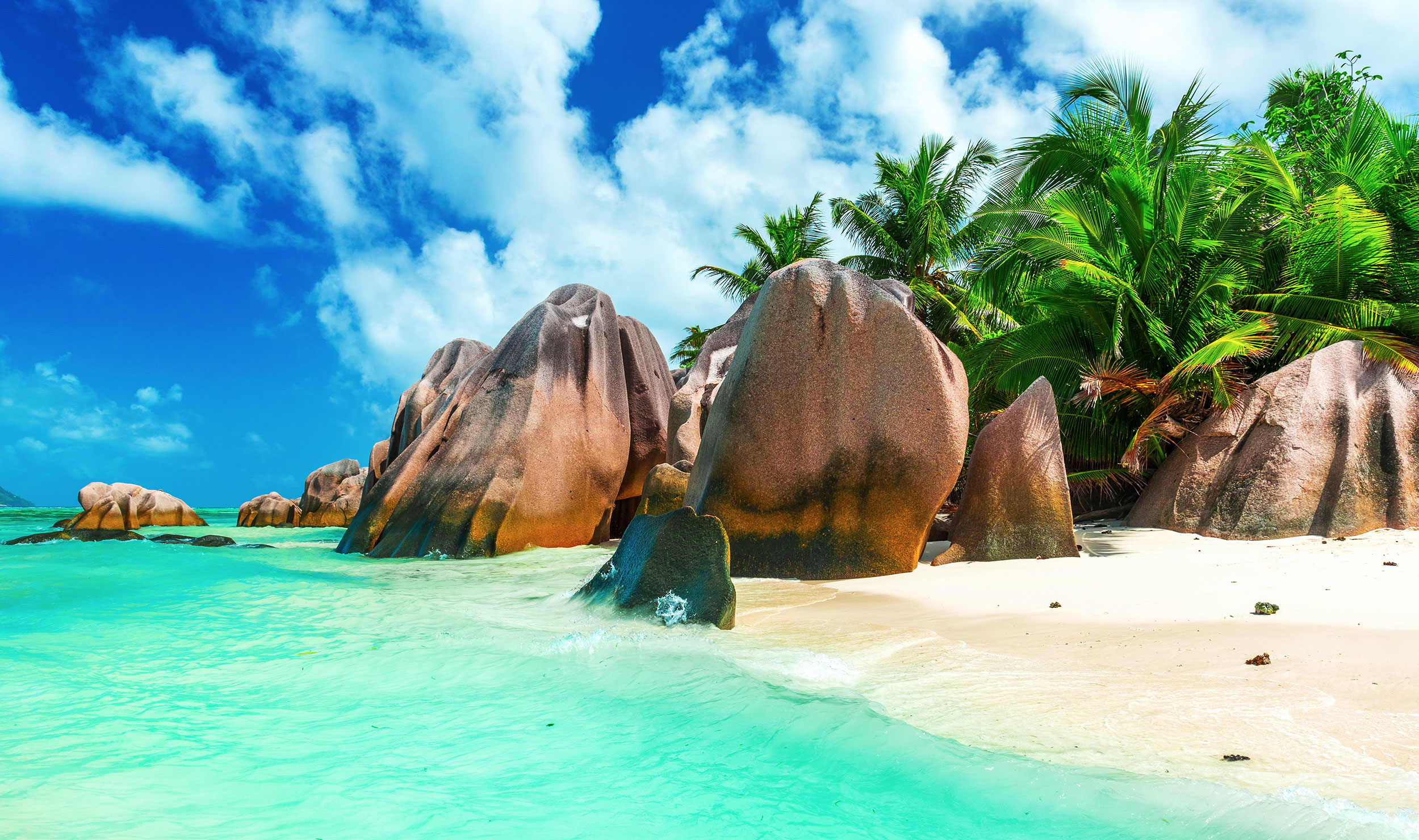
You can take a day trip to the neighboring islands together with a group excursion. Photo: Simon Dannhauer / Shutterstock.com
First, they brought us to Praslin Island, and from here we went to Vallée de Mai National Park and the place where the coco de mer palm tree is growing. The piquantly shaped giant coconut can only be found in the Seychelles. The palm can reach heights of 30 meters.
You just won’t be able to bring a nut back as a souvenir: first of all, it can cost several hundred to several thousand euros, and secondly, you need to get a permit for this in an office of environmental protection and have an excise stamp.
Then we went off to the island’s most famous beach, Anse Lazio. In about 10 minutes, a wave struck me so hard that it washed away my sunglasses. Having said goodbye mentally, children found them on the shore half an hour later.

Anse Lazio Beach.
Then we went over to La Digue. Compared to Praslin, this is a very small island – there are approximately 2000 people living here. Tourists and locals get around the island on foot or by bicycle. They took us to the L’Union Estate nature reserve, the location of the island’s main attraction – the beach Anse Source d’Argent, which National Geographic called one of the world’s top ten beaches.
It is famous for its huge granite boulders that are strewn on the shore. Entrance to the nature reserve costs 115 rupees. This is where you can see gigantic Seychelles turtles from Aldabra Island, which weigh up to 300 kilograms and are up to 120 centimeters long; they can live as long as 150 years.
I would like to warn travelers with week vestibular systems: you might get very seasick during transportation between the islands. The road became a real test for me. I advise you to sit in the back rows, keep your head straight, and look forward. Don’t overeat in the morning and don’t drink alcohol before you return back. We told you how to deal with motion sickness in a separate article.

Anse Source d’Argent Beach.
What to bring back
The tea that they grow at local plantations and dishes made from coconuts, coconut oil for eating and massage purposes, aromatic oils, spices, and exotic fruits (if you have space in your luggage). It’s best to buy all of this at the market in Victoria. The prices are lower than at the tourist spots.
I recommend that you look at souvenir magnets in the airport’s departure area: there’s a bigger selection and the prices are the same as in the city. And don’t forget about Takamaka rum, which is made in the Seychelles from saccharum officinarum and water from mountain springs on Mahé: a 250 ml bottle will cost you 24 euros.

It’s best to buy aromatic oils, spices, and exotic fruits on Sir Selwyn Clarke Market.
What you should remember before your trip
Daylight hours are short in the Seychelles: The daylight only lasts from 6 a.m. until 6 p.m. After 6 p.m., you can go to a restaurant on the shore of the ocean or at a hotel; there is no other evening and night entertainment here.
There may be problems with roaming: For example, I activated the “Zero without borders” service with MTS to remain connected. It turned out later that the option does not work in the Seychelles even though money was debited for this. I recommend that you choose a place to live with a stable Internet connection.
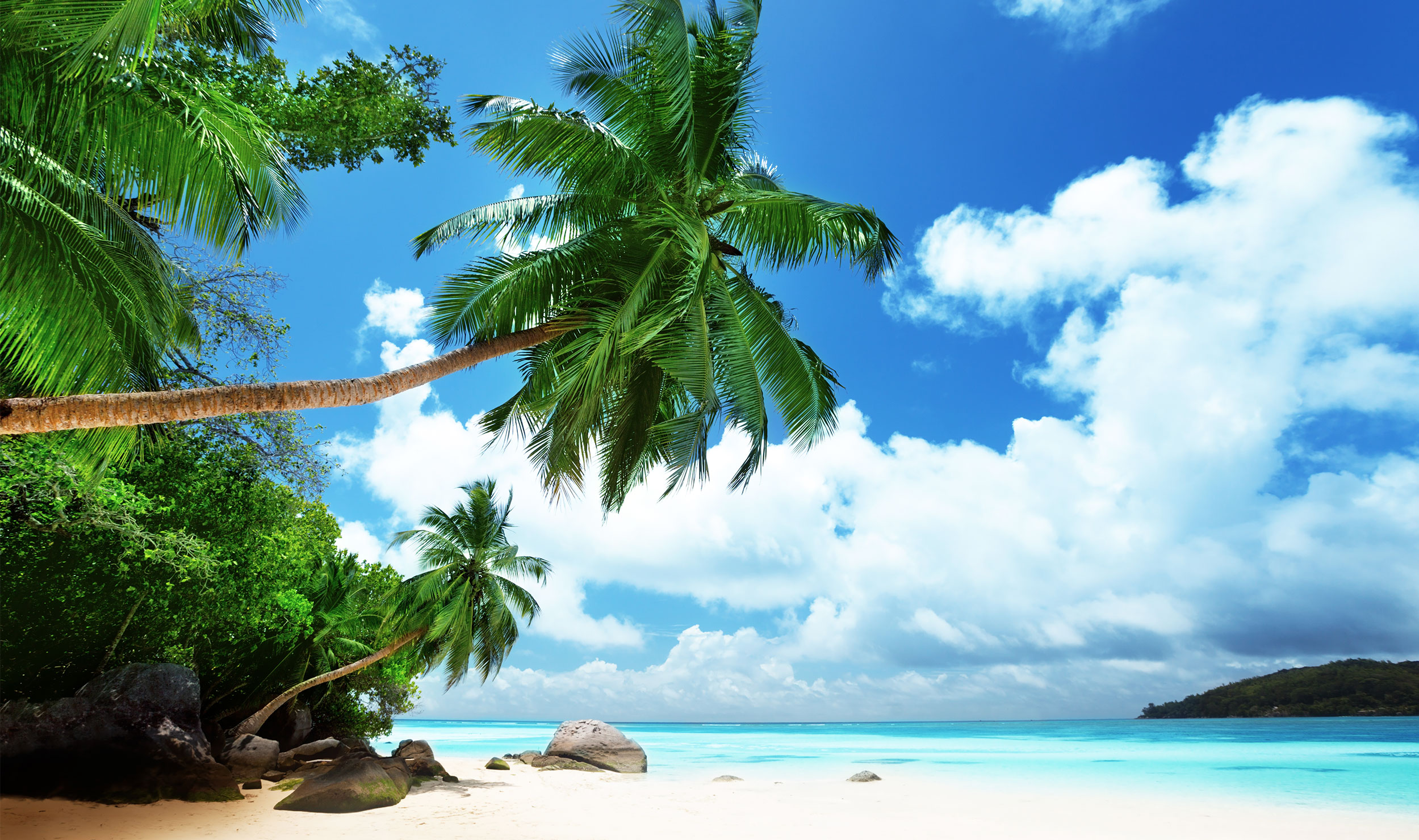
The daylight only lasts from 6 a.m. until 6 p.m. Photo: ESB Professional / Shutterstock.com
Dollars or euros are best in the Seychelles: There is a currency exchange office at the airport. They may accept euros or dollars as a method of payment and give change in rupees.
Don’t forget sunscreen: The Seychelles are located near the equator. Make sure you bring a sunscreen with an SPF of at least 30. You won’t need swimming shoes, but if you love snorkeling, make sure you bring them with you so you don’t accidentally step on a coral and hurt yourself. There are no dangerous insects here – in the Seychelles, it is safe even in the jungles.
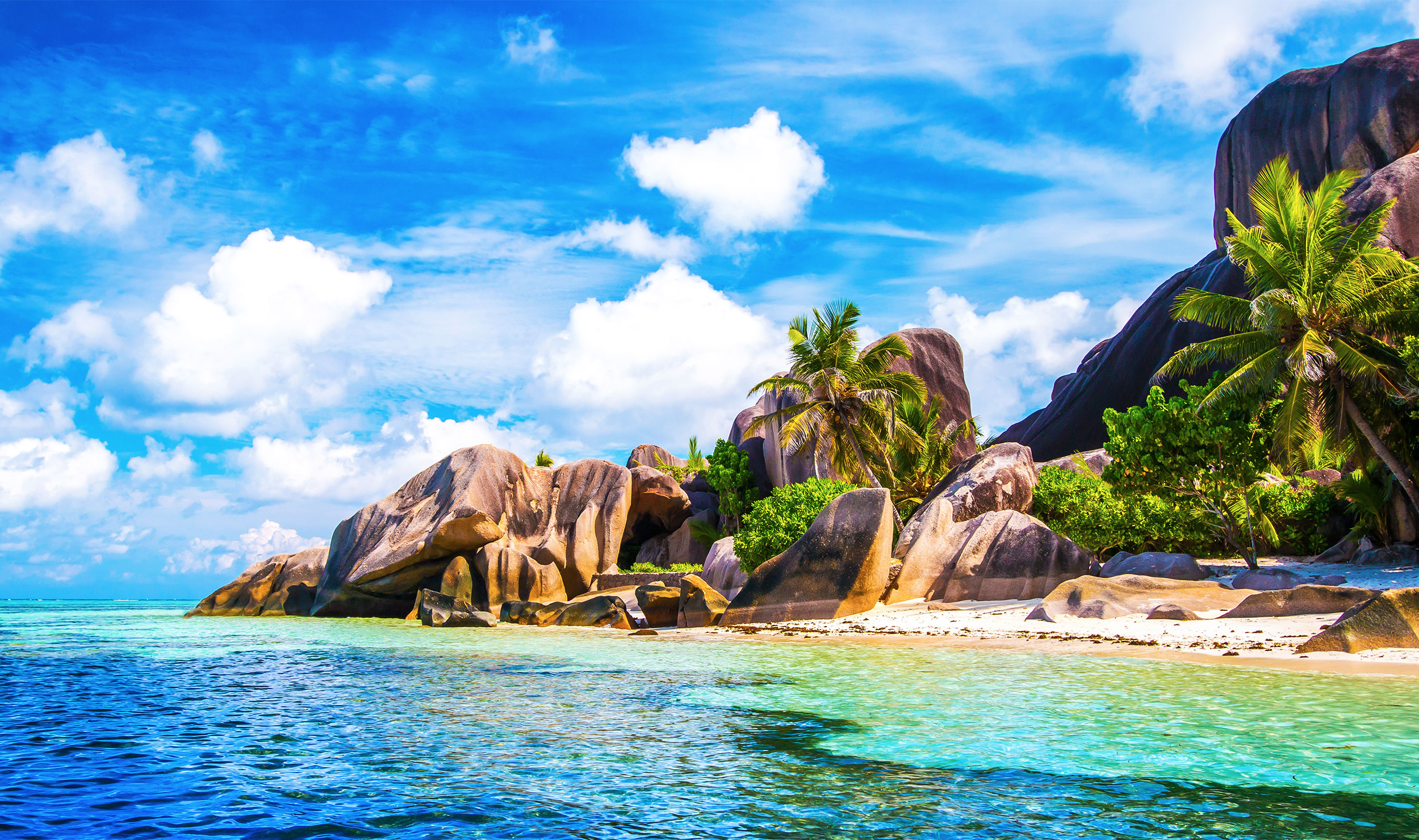
Make sure you bring a sunscreen with an SPF of at least 30. Photo: Zoltan.Benyei / Shutterstock.com
The Seychelles are a unique place on the map of the world. This is the only place where the coco de mer nut grows and the world’s largest Aldabra turtles live.
These are green islands covered by jungles that are safe to walk in. Outdoor recreation enthusiasts will enjoy wandering through the national park and then taking a dip in the warm but fresh ocean later.
Such a vacation is not only suitable for couples in love, but also for active travelers who love the mountains and the ocean in equal measure.

